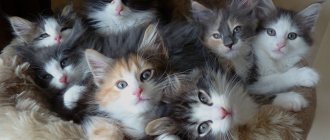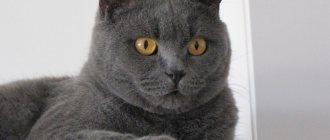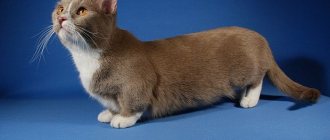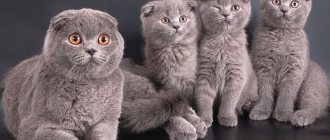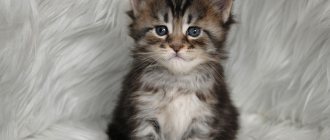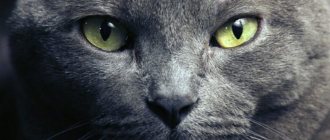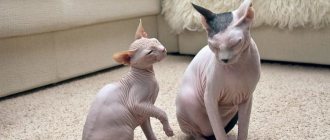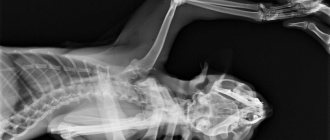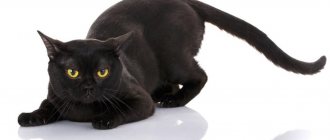History of the origin of the breed
The cat's homeland is Norway, as its name suggests. The Norwegian forest cat appeared quite a long time ago; back in 1599, the Norwegian priest-naturalist Peder Clausson Friis told the world about this furry animal.
There are many legends and myths surrounding the origin of the Norwegian Forest cat breed, told by the peoples of northern Europe. In one of the myths, the chariot with the goddess of love and war Freya was driven by large fluffy cats. Another legend says that the god of thunder and storm lost his powers thanks to the sea serpent Jormugand, who crept up to the god in the guise of a Norwegian cat.
Viking cat is another name for this breed. It is believed that these cats were brought by the Vikings - medieval warrior-robbers. Cats were kept on ships to kill rodents. The name stuck, but the version about the origin of the breed has not yet been confirmed.
In Norway, these cats were considered ordinary, and they lived in forests and on farms. Man took minimal part in the formation of the breed; it developed naturally. Therefore, the Norwegian cat is considered an aboriginal breed. The Norwegian Forest Cat gained its fame (as a breed) only in 1938. At the exhibition held in the city of Oslo, the first cat of this breed, which has a red and white color, was presented.
Officially, the Scandinavian (Norwegian) breed was registered in the FIFE standard in 1977. The national breed standard was adopted a little earlier - in 1973. This breed is the most popular in Scandinavia and is in demand in many other countries.
How to choose a kitten
Like any other purebred cat, the Norwegian Forest should only be purchased from reputable catteries or from trusted breeders. An attempt to save money and buy a pet at the “bird market” or through private advertisements most often ends with you getting an ordinary fluffy “nobleman” or, even worse, a baby with a lot of genetic abnormalities. If you plan to participate in exhibitions, you should carefully check the pedigree of the parents and the compliance of the kitten with the approved breed standard, because minor flaws from the point of view of an amateur can lead to low expert ratings and even disqualification. It is extremely difficult to assess the quality of wool at a young age, so here they focus on the external data of the parents.
The general requirements for a kitten of any class are simple:
- mobility, playfulness and curiosity, which indicate normal development and health;
- a good appetite;
- clean eyes and ears without foreign secretions;
- pink gums;
- absence of skin parasites;
- slightly rapid, but even breathing after physical activity (the opposite indicates problems with the cardiovascular system).
Important indicators are also the living conditions of the mother and kittens - sufficient space for active play, cleanliness, availability of toys, regime and quality of food. Be sure to ensure that the first required vaccination has been completed.
Appearance
Norway's national treasure, the Viking Cat, is distinguished by its strong, muscular body and fluffy, thick coat, ideal for the harsh conditions of Scandinavia. The Norwegian Forest Cat is described in all international standards, each of which has different requirements for the exterior. The main characteristics are similar, but there are a number of differences.
Let's look at how the WCF standard describes the Norwegian breed.
Breed standard according to the WCF system
- Body . Elongated, strong, with massive bones. Sizes – from medium to large.
- Head . In the shape of an equilateral triangle.
- Muzzle . The profile is long and straight, without a stop.
- Ears . Big ones. The base is wide. Located very high on the head. The outer line of the ear runs along the cheeks in a straight line. The ears have a long edge on the inside. There are “lynx” tassels at the tips.
- Chin . Solid.
- Nose . Not described by the standard.
- Eyes . Oval shaped, large and wide open. The color is even and matches the coat color.
- Limbs . Muscular, long. The hind ones are longer than the front ones.
- Paws . Round shape, wide. Between the fingers there are tufts of wool.
- Tail . Very long and fluffy. Must be equal to body length or greater.
- Wool . Double layer. The upper guard hair is long, shiny, hard, and has water-repellent characteristics. The undercoat is thick and fluffy. The guard hair covers only: the back, sides, forelimbs, outer part of the hind limbs and the upper part of the tail. The lower part of the body and the back of the hind legs have only undercoat. On the hind legs there are “breeches.” A triangle-shaped beard hangs from the cheeks.
- Neck . The fur on the neck forms a “jabot”.
- Color . The standard allows any colors and patterns. The exceptions are chocolate, cinnamon (red-brown), lilac and fawn (fawn). Solid coat color should be uniform. The pattern of spots in bicolor and tabby patterns should be clear and distinguishable. Any amount of white is allowed.
- Drawing . All species are allowed: tabby (marble, spot, stripe), tortoiseshell, mackerel, van, harlequin, wild. Color point is prohibited.
- Weight . Females - 3.5 - 5.5 kg, females - 4.5 - 7.5 kg.
- Height at withers . From 30 to 40 cm. Short individuals are considered a disadvantage.
- Lifespan . From 14 to 16 years old.
Important!
Among cats there are long-livers, whose life expectancy is more than 20 years.
Brief description of the breed and distinctive features
Distinctive features of representatives of this breed: thick hair, powerful build, large size, strong bones and a pubescent, very fluffy tail. Their weight is approximately 8-10 kilograms .
These individuals have a rounded head and a short, powerful neck. The ears are set high, pointed, and if you look closely you can see the tassels. Also, representatives of this breed have thick and long mustaches. The hind legs are slightly shorter than the front legs and their muscles are well defined.
Colors of Norwegian cats with photos
The colors of Scandinavian cats can have completely different shades and intricate patterns.
Consider popular colors:
Black
Large, beautiful charcoal-colored cats look impressive and respectable. There are pure black animals without a single white hair. But the standard does not prohibit small inclusions of white fibers and white spots.
Red
Red or red-haired Norwegians look very impressive. Shades of red range from bright red to fawn. There may be a white pattern on the body or small patches of white hairs.
White
White fluffy cats look like real beauties. But at exhibitions there are increased demands on such pets - the gene responsible for white color can lead to deafness of the animal.
Tortoiseshell
Tri-colored tortoiseshell cats (and only cats can be tortoiseshells) bring happiness and good luck to their owners. This, of course, is a popular belief that not everyone believes in. But getting yourself such a luxurious beauty is already a great success.
Tabby
The wild color is most associated with this breed. This is exactly what the ancient Viking cats looked like. There are many variations of this color in Norwegian forest cats. These are marbled cats, and tabby, and ticked, and spotted.
Van, harlequin and bicolor
All three colors are similar, differing only in the location and number of colored spots on the cat’s white body. In our country, cats of this color (white and spots) are rare. In Europe, such pets are highly valued. White fluffy dandies with a flowing colored tail look incredibly impressive.
Important!
Only the Norwegian Forest breed has beautiful rare colors of amber (amber) and light amber (lightened amber). These colors are usually called gold or precious.
If furry pets are not your thing, consider the Bengal and Thai cats.
Exterior of a cat
The breed is native, has dense and flowing long hair, a luxurious collar, a bushy tail, and is strongly built. Many breeds are divided into 2 types: classic and extreme type, Norwegians are no exception. Natural selection led to the emergence of the classical type. The Extreme was created through various changes caused by a deliberate attempt to increase the original characteristics of the breed: larger ears, a more elongated profile, etc.
What are the characteristic features of Norwegian forest cats?
First of all, it is large in size, long coat with a thick undercoat that repels water well. This quality is vital for them to live in their homeland in the cold, snow, and rain. Lying on the ground, they can additionally warm themselves with their fluffy paws and cover their muzzle with a bushy tail.
Body
The bones are strong, the animal itself is very large, with well-developed muscles, strong, with a wide chest. Body length is average. Females are smaller in size than males.
Head
Located on a short, muscular neck. Looks like a triangle with equal sides. The chin is strong, the nose is straight and above average in length.
Eyes
The color of the eyes and fur matches each other, the eyes are clean, large, wide open, clear. Placed slightly obliquely, almond-shaped or oval in shape.
Appearance
Males are clearly different in weight from cats. The weight of cats is 6-8 kg, and that of females is no more than 4-5 kg, but they look larger due to the increased thickness of their fur. The breed itself is designed to survive in harsh climates.
Colors
Forest mouse hunters have a fairly wide range of coat colors. Exceptions are chocolate, lilac, cinnamon and fawn colors, as well as color points, which cannot be obtained from representatives of the northern forest breed. Among the painted colors there is practically no white.
[AdSense-B]
The restriction on colors was lifted only in 1980, when FIFA divided cats into 2 groups: solid and patterned colors. Three years later, each group diversified by including white in the list of acceptable colors. There are currently 9 color groups.
“Wild colors”, which lack white, have remained popular everywhere. The most impressive are tortoiseshell, red, harlequin, and van colors.
Features of the appearance of the Norwegian breed:
- Having a developed chest and a neat, toned stomach;
- The paws boast strong claws and toes;
- The croup rises slightly above the shoulder blades. The hind legs are high;
- The body is somewhat stretched;
- Compared to Siberians, Norwegians have almond-shaped eyes rather than oval ones. Plus, the height of their cheekbones is significantly greater. We also highlight an elongated tail with better feathering (according to experts), a more delicate and neat muzzle.
Standards and requirements
Looking at the forest one, you might think that it is very heavy and, accordingly, not dexterous. However, this is not the case; the Norwegian has a strong hunter and fisherman design. And very fluffy fur, which is why it seems so massive. The average weight of a Norwegian woman as an adult is no more than 7 kilograms, a Norwegian is a maximum of 9-10 kilograms.
There are significant differences in sexual dimorphism. A cat always has a more serious face, more powerful legs, a broad chest, larger size and increased “fluffiness”.
The long coat of the Norwegian breed has a developed warm undercoat. The chest and neck are decorated with a lush mane. Looking at the back of the paws, you can see beautiful pants. There may be tassels between the fingers and on the ears. However, if they are not there, then this is not a disadvantage for the pet. Note that many winners of international competitions did not have brushes at all.
The most stringent requirements for wool should be met. Hair must NOT be silky, soft or thin. Nervegas are animals from the forest, so they need a durable fur coat that can retain heat well and repel water. In addition, thin and soft wool can mat in tangles. But this is unacceptable for the Norwegian Forest.
If you are specifically interested in show kittens, you should judge the quality of the fur coat by looking at the mother and parent of the animal. Please note that the baby will in any case have too fluffy and childishly soft fur.
As for colors, a huge variety awaits you here. Only those colors that can indicate the presence of foreign blood (Siamese) are prohibited. Exhibition specimens must not be chocolate, cinnamon, fawn or lilac in color. The tail, ears, muzzle and bottom of the legs should not be covered with dark areas.
Care and maintenance
To get yourself a big, fluffy, handsome cat, you need to prepare and study the features of keeping it at home. It is also important to calculate your strength and estimate the budget that will be required to care for such a pet.
Content Features
The first thing Norwegian Forest cats need is space. Yes, this breed is owned by city apartment owners, but it is better that it is not a small one-room apartment. Cats are large, active, athletic, and need room to climb. In a large private house, Norwegian forest cats feel more at ease.
In addition, representatives of this breed love to walk in the fresh air. Fresh air is good for appetite and coat. They can be walked on a leash or released into the yard of your home if you are sure that it is safe there. Norwegians are excellent hunters - don’t be surprised if your pet starts bringing you prey from a walk. Moreover, it can be not only mice and birds. Norwegians are not afraid of water, they know how to fish. Some owners build spacious enclosures in their yards for their pets.
In Europe, adult cats are sometimes kept in enclosures that contain insulated enclosed houses. But, only adult (most often elderly) cats who previously lived with people in the house. Constantly keeping an enclosure from an early age will lead to the animal going wild.
Cats of this breed love and know how to climb vertical surfaces. This is the only breed that nature has taught to descend from trees in a spiral (like a squirrel) upside down. If you have a special tree at home (a vertical play structure up to the ceiling), cats will climb it. If there is no tree, they will climb doors and cabinets. They do it very cleverly.
Grooming
The luxurious wool of the Norwegian is the main advantage of the cat and the subject of care and attention for the owner. The peculiarity of the breed is semi-long, waterproof guard hair and a dense, thick undercoat. To keep the house clean and your pet’s coat in good shape, you need to comb the pet’s fur at least twice a week. This is done first with a sparse comb with non-sharp teeth, and then with a brush with natural bristles.
Your pet's coat requires special care in the spring, when seasonal shedding begins. Before the onset of the warm season, Norwegian forest cats completely shed their undercoat. All summer they walk around looking different from the furry pets they were in the winter. In autumn, a new undercoat grows, the coat becomes longer and thicker. At this time, the owners will have to comb the cat daily, and it is best to use a furminator.
There is no need to bathe cats unless absolutely necessary. This is difficult to do, since Norwegian wool is waterproof. If the animal is heavily soiled, it is best to try to wash only the areas of contamination. The exception is for show class pets - they are bathed with special grooming products before shows and competitions.
Dental care
To prevent periodontal pathologies, the cat’s teeth and oral cavity are cleaned with a special brush and veterinary toothpaste at least once a week. Only a doctor in a clinic should remove tartar. In order to promptly detect hard deposits on teeth, it is necessary to regularly undergo preventive examinations with your pet in the clinic.
Eye care
The pet's large eyes are examined daily and wiped with a damp cotton pad to clear any discharge. A different disk is used for each eye. If the discharge from the eyes is colored, foul-smelling discharge is a reason to immediately contact a veterinarian.
Nail care
The animal has long claws. If a cat leads an active lifestyle, climbs a lot, uses a scratching post, and walks, then the claws will wear down naturally. If the claws are not worn down enough, they are trimmed with special veterinary scissors. This is done carefully when the animal is relaxed. It is not recommended to hold a resisting pet by force - this causes psychological trauma to the animal.
Ear care
Large cat ears do not require much care. They need to be examined weekly, and if necessary, wipe the auricle with a damp swab. Do not use cotton swabs for ear care - this can injure the inside of the ear.
How much money do you need for care and maintenance?
When purchasing a purebred pet, you need to evaluate your financial capabilities and know how much it will cost to buy a kitten, accessories for its maintenance and how much you need for monthly quality care.
What to buy for a kitten
Required set:
- Two or three bowls (2 – natural food, 3 – ready-made food). Choose a large bowl for water - Norwegians like to splash water with their paws. Ceramic or metal ones on a stand are best. Price: 380 – 1300 rub.
- Tray. Large with deep sides. Large cats should have room in it. Price: 2700 – 1300 rub.
- Wide-toothed comb and brush with natural bristles: RUB 340 – 600.
- Scratching post. Vertical, wall-mounted for large cats: 900 – 3500 rub.
- Toys. Intellectual pointers, balls, and laser pointers are suitable. Price: 700 – 3000 rub.
- Bed. Large, suitable for dogs: 800 – 1900 rub.
Additional products:
- Plastic carrier with metal door. It is best to take models for dogs. Price: 2500 – 8000 rub.
- Stable vertical play set with weights and sisal scratching posts. Price: 10,000 – 15,000 rub.
- Claw cutter. Price: 350 – 500 rub.
- Harness with leash. Price: 850 – 1500 rub.
- Anti-cat bars for windows. Price: 1800 – 2500 rub.
- Furminator for long-haired cat breeds. Price: 1200 – 2400 rub.
Annual care for a Norwegian forest cat may require from 20 to 60 thousand rubles.
The budget will depend on your capabilities, the chosen diet, the type of filler, and the frequency of treatment and preventive measures.
Feeding pets of this breed is not difficult, but you need to take into account that their coat requires good nutrition: complete, balanced and fortified.
Health and illness
The Norwegian Forest breed is indigenous, that is, it was created naturally under the influence of harsh external conditions. Human intervention in the creation of this breed is minimal. Cats are muscular, strong, and easily adapt to cold and wet climates. But, like all breeds, they are prone to certain diseases.
Genetic pathologies of the breed
- Glycogenosis type IV. The disease is rare, detected only in Norwegian cats. With this pathology, glucose metabolism in the animal’s body is disrupted. Kittens are stillborn and die within the first hours after birth. In some cases, signs of the disease appear only at the age of 5-8 months. The disease is fatal and has no cure. Detected by the results of genetic tests.
- Hypertrophic cardiomyopathy. Hereditary heart disease is common in large cat breeds (such as the Maine Coon). Can be detected by DNA tests.
- Hip dysplasia. Pathology of joint development leads to discomfort, pain and lameness. Detected by hip x-ray.
- Polycystic kidney disease, a hereditary pathology that gradually destroys the kidneys. Detected by ultrasound at 10 months of age. DNA tests are not available for this disease.
To protect yourself from these serious hereditary pathologies, it is necessary to ask sellers and breeders for the results of tests and examinations of the kitten and its parents.
Treatment and preventive measures
In order for your pet to live a full, healthy life, you must not neglect preventive measures:
- vaccination according to the vaccination schedule and compliance with quarantine measures;
- antiparasitic treatment for external parasites (at least 2-3 times a year);
- anthelmintic measures (2-3 times a year);
- ensuring a high-quality balanced diet;
- vitaminization.
Annually, treatment and preventive measures may require from 4,000 to 6,000 rubles.
Important!
If you do not plan to become a breeder of a Norwegian forest cat, in the first year of a kitten’s life, budget for the cost of sterilization (castration) surgery - 1500 - 4000 rubles.
Feeding
Each owner chooses the type of food (natural or prepared food) himself. Some owners stick to the diet that the breeder fed the kittens. If you are in doubt when choosing the type of food, it is best to consult a veterinarian or professional Norwegian Forest Cat breeders.
Natural nutrition
The Norwegian cat appeared naturally - it is a real predator from the forests of Scandinavia. Predators eat meat. In the case of the Norwegian breed, it is also a fish. These cats are excellent fishermen.
Therefore, the basis of the diet (70%) should be meat, meat products and fish. The rest is vegetables, herbs, dairy products.
- Dietary meats: rabbit, veal, turkey, chicken.
- By-products: lung, liver, heart.
- Fish: low-fat sea varieties. Give once a week in boiled form.
- Vegetables: zucchini, carrots, pumpkin, broccoli, beets.
- Low-fat fermented milk products: cottage cheese, fermented baked milk, kefir.
- Natural yogurt.
- Eggs. Quail or chicken yolk.
- Greens: spinach, lettuce, sprouted oats.
- Bran.
- Yeast.
- Vitamin and mineral complex according to age and health status.
Meat and meat by-products are given raw. To get rid of possible parasites and bacteria, meat products are frozen for 2-3 days. Thaw at room temperature before serving to the cat. There is no need to mince the meat - the meat is cut into pieces. The cat must have stress on its gums and teeth.
List of prohibited products:
- legumes;
- exotic vegetables and fruits;
- potato;
- corn;
- whole milk;
- fat sour cream and cream;
- pork;
- kidneys;
- sausages and sausages;
- smoked meats and canned food.
With this type of nutrition, the feeding rate is calculated using the formula: daily rate = 7% of the cat’s weight. Adult pets need only two meals a day.
A monthly natural diet will require 1,500 to 3,500 rubles.
Industrial feed
The main requirement for industrial feed is balance and nutritional value. Economy class food should be abandoned initially - it contains few nutrients, but a lot of dyes, flavor enhancers and artificial flavors and preservatives.
The choice should be made in favor of quality brands of at least “super-premium” class.
The pet industry produces ready-made food specifically for this breed, but any brand for large cats will do.
Recommended brands of food:
- Orijen Cat Fit & Trim Grain Free – a grain-free brand for pets prone to gaining excess weight;
- Acana Regionals Pacifica Cat Grain-Free – Grain-free, fish-based formula for cats and kittens;
- Carnilove Adult Cat Large Breed Duck & Turkey Grain-Free – with duck and turkey for large cats;
- Brit Care Tobby I'm a Large Cat - Duck & Chicken Grain-Free Hypoallergenic - hypoallergenic formula for adult large pets;
- Royal Canin Norwegian Forest Cat is a super-premium food for the Norwegian Forest cat breed.
On average, Norwegian cats need 50-120 grams. dry food per day. The individual rate is calculated depending on the weight, age, activity and condition of the pet.
Monthly feeding with ready-made food will require 1000 to 3800 rubles.
Important!
Norwegians are large cats with a good appetite. Throughout their lives, it is necessary to control their weight and prevent overfeeding and obesity.
Proper nutrition
With feeding everything is quite simple:
- Ready-made dry food or wet canned food. Choose super premium or holistic products. If you buy premium food, you will need vitamin complexes in addition to it. You should not feed your Norway cat with economy food.
- Natural nutrition. Your pet will be happy with offal (hearts and kidneys), poultry (turkey and lean chicken), and dietary meat (rabbit and veal). The products we have indicated should not just be included in the forest diet. It should make up the majority of the food in your bowl each day. The amount of natural meat in one serving of food for an adult cat is at least 100 grams. Do not mince the meat. The Norwegian should be able to exercise her gums.
You can give fish once a week maximum. But not river or lake, but sea (boneless fillet). Pickles, sweets and smoked foods are contraindicated for Norwegians, as well as for representatives of other breeds. In a ratio of 5 to 1, give meat and whole grain porridge, or chopped greens, or cabbage, or stewed carrots. Greens are special cat grass offered in pet stores, oats or wheat germ.
Dairy products (low-fat cottage cheese, natural yogurt and yogurt), as well as eggs, will allow your cat to get enough protein.
Natural products or balanced feeds? It is impossible to answer unequivocally. You can train your pet to do both. The main thing is that the food is complete and of high quality. Please note that premium and holistic foods do not contain artificial flavors, which are so attractive to animals. Therefore, an adult cat or cat may refuse such food. Children should be taught ready-made canned food and dry food from childhood.
FAQ
How many live at home?
With good care and nutrition, healthy representatives of the Norwegian breed live a long time. On average - 14-16 years. They can live more than 20 years; such cases have been recorded in the history of this breed.
What is the weight of an adult and a kitten?
Norwegian cats are larger than cats. At six months they can weigh 3-4 kg, by two years 7-8 kg. Kittens at 6 months weigh about 1.5 kg, at two years they reach a weight of 4-5.5 kg.
Is it easy to hold?
The cat is not tame. Norwegians value their own and their personal space.
They do not like to sit on their laps, preferring to be close to them, curled up in a ball. They don't like to be kissed, but they love to be stroked and scratched. As a sign of love and appreciation, they can “butt” a person’s forehead or legs.
Can I keep it outside?
We have already written that in Europe cats are kept in cages in nurseries. But this applies only to adults who have lived and been raised in a family since childhood. Kittens cannot be placed in enclosures. Yes, cats can withstand the harsh conditions of the street, but they run wild there. An aviary is needed for walking this breed. Fresh air has a beneficial effect on the quality of their luxurious coat and improves their appetite.
How aggressive is the breed?
Norwegian Forest is absolutely not aggressive. Representatives of this breed do not show aggression towards children, other pets, or strangers. They are calm and balanced. They don’t divide the territory, they don’t start wars. Behind the stern appearance hides a gentle, good-natured animal.
Do they like to claw/climb?
The forest cat's favorite pastime is climbing trees. This is what the Norwegian forest dog does with pleasure. There are no heights that are inaccessible to them. Cats deftly climb vertical walls, doors, and cabinet doors. What is surprising is their ability to descend upside down - they do it without panic, quickly and easily. Cats are smart, so it won’t be difficult to train them to scratch their claws on a scratching post.
Is this breed hypoallergenic?
The breed is not hypoallergenic. The fur of a Norwegian cat can cause allergies.
Do you need to take care of your fur?
The Norwegian's double coat requires regular grooming. Under normal conditions, it is enough to brush your cat 1-2 times a week. During the molting period, they do this daily and use a furminator.
What color are eyes?
Almost anyone. A golden-green shade is preferable, but copper, gold, and green can also be used. White cats have blue eyes.
Is the breed prone to heart disease?
Unfortunately, nature did not spare these large, strong cats. They live easily in harsh conditions, but can inherit heart disease such as hypertrophic cardiomyopathy.
At what age do they stop growing?
Like all native breeds, Norwegian cats develop slowly and mature late. They reach full maturity by 4-5 years, while they retain the temperament of a kitten almost all their lives.
Reviews from Norwegian Forest Cat owners
Irina : “My Nafanya is a little Norwegian miracle! He never let out his claws. I never, ever walked past the stall. Always nearby, but does not try to beg for attention. Loves to sit next to me when my husband and I watch TV. Right next to us so that we can see - here I am! When guests arrive, he first peeks around the corner, gets used to it and takes a closer look. If he is noticed and called, he runs happily and can play with the guest. The coolest thing is that he knows how to feel sorry. I’m going to cry, Nafanya immediately comes running and licks away the tears, calming me down. I don't want to cry right away. He never yells. Even if we forget to give him food. He can sit silently and sadly near the bowl for hours. This is so touching".
Denis : “My cat is already 9 years old. But he doesn't give the impression of being an "old man." They say that Norwegians take a long time to grow up and do not age for a long time. He replaces my dog. He waits for me from work, meets me at the door, sleeps nose to nose. He can answer me in cat language if I tell him something. What else? He brings a ball and a mouse, just like dogs do. I walk him on a leash every day. Frosts are not scary for him, he even loves this weather. We go out all year round. In winter, he is drawn to the window frame - it’s cooler there. Can lick ice off glass like moose lick salt.”
Raisa Petrovna : “I have had many different cats throughout my life, but this is the first time. When a neighbor’s dog chased Marquise up a tree in the courtyard of the dacha, I got scared and went to look for a ladder. Imagine my surprise when I saw a cat on the ground. Then she herself climbed the apple tree several times. I saw her getting down. From the outside it looked like a huge squirrel with a fluffy long tail. She deftly moved her paws and moved upside down. No other cat in the world can do this.”
Video reviews:
Popularity of the breed
Due to the high competition in the group of semi-longhair cats, Norwegians cannot earn an exhibition rating. The main competitors are Siberian cats and Maine Coons. Most often, Norwegians participate in FIFA shows. Most animals live in Scandinavia and Germany.
An interesting story about one of the Norwegians begins in 2000, when the Belgian designer Seppe Slabbinck bought a kitten of this breed, but was forced to urgently leave on business the very next day.
He did not want to leave the baby to strangers so much that he simply put her in his pocket and calmly went about his business. From this day on, the tradition of joint trips and visiting various events stretched for many years. Seppe took the cat with him to restaurants, where she took her place on a chair next to the owner and never behaved badly and did not receive a single complaint against her.
How much does a Norwegian Forest cat kitten cost?
The price tag for Norwegian Forest cat kittens has a wide range - from 12,000 to 90,000 rubles. (4,000 – 35,000 thousand UAH).
What does the price depend on?
The price of a kitten depends on:
- Pedigree and titles of parents.
- The breeder's expenses for maintaining a kitten, organizing an exhibition career for producers.
- Breed characteristics (belonging to a certain class).
- Sales with and without breeding rights.
- Rarities of color.
About 80-85% of the cost depends on the class:
- SHOW (show) – the highest class. The kittens fully comply with the breed standard. Used only for breeding and exhibition activities. Price: from 65,000 to 90,000 rubles;
- BREED - healthy kittens without genetic pathologies and good characteristics, with a slight discrepancy with the breed standard. They can participate in exhibitions and shows. They cost from 30,000 to 50,000 rubles.
- PET (pet) - purebred kittens with minor deviations from the standard or minor defects are not allowed for breeding and exhibitions. Price: from 12,000 to 25,000 rubles.
Where to buy a Norwegian Forest kitten
There are breeders and nurseries in all major cities of Russia and Ukraine.
In Russia
- Nursery “IXTLAN”, Moscow – https://move-ixtlan.ru/;
- “NORTH CAPE*RU”, St. Petersburg – https://northcape.ru/.
In Ukraine
- There are no nurseries
Those who want to buy cheaper can purchase a kitten through bulletin boards on the Internet. They offer the offspring of Norwegian forest cats for 3,000 – 5,000 rubles. (1,500 – 2,100 UAH). However, do not expect that for that kind of money they will sell you a purebred, healthy kitten with good characteristics.
Character of the breed
Among breeders, these pets have good characteristics. Despite the harsh Scandinavian climate of their ancestors and their external resemblance to wild lynx, cats are very friendly, balanced and non-aggressive. If there are small children in the house, then the cat will prefer to bypass them and wait in a secluded place. If the attempt to retreat fails, he will not resist. It will not release its claws towards humans.
Not emotional. Sociable with all family members, but respects only one owner. Loves affection. These cats are naturally intelligent, and therefore easy to educate and train.
It should be noted that the Norwegian cat matures late. Her playful hunting disposition continues into old age.
